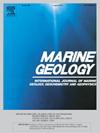基于矿物和生物成因碳酸钙组成的Kikai岛附近晚更新世至全新世浊积岩源区估算
IF 2.2
3区 地球科学
Q2 GEOSCIENCES, MULTIDISCIPLINARY
引用次数: 0
摘要
确定浊流的初始位置有助于揭示古地理、潜在的石油储集岩和古地震史。因此,浊积物源面积的估算方法至关重要。本文利用位于琉球弧中部的Kikai岛附近的海洋岩心沉积物和表层沉积物估算了浊积岩的源区。重点从矿物组成、粒度分布变化和微化石组合等方面对源砂的水深和腹地地质进行了估计。在弧前斜坡的海洋岩心中发现了具有正常级配或层状结构的钙质浊积岩。通过x射线衍射(XRD)分析,比较了这些钙质浊积岩与表层沉积物的碳酸钙矿物组成。文石和镁方解石的比例与方解石相反,随着水深的增加而减少,与有孔虫和翼足类的栖息地相对应。建立了碳酸钙矿物比与水深的回归方程。浊积岩源的预测水深与底栖生物/浮游有孔虫比值的预测水深相当。此外,通过XRD结果的主成分分析和粒度分析,与腹地地质的地表沉积物对比,在空间上约束了浊积物的源区。由于浊积岩沉积仅限于14.7-9.7 ka,我们解释了在海平面快速上升期间,珊瑚礁淹没导致沉积物供应增加,钙质砂床不稳定并由浊流输送。该方法为浊积岩的供应来源估计提供了一个框架,有望用于古地震研究和油藏评价。本文章由计算机程序翻译,如有差异,请以英文原文为准。
Estimation of turbidite source area in late Pleistocene to Holocene around Kikai Island based on mineral and biogenic calcium carbonate composition
Identifying the initial location of a turbidity current can help reveal a paleogeography, potential petroleum reservoir rocks, and a paleoseismic history. Therefore, a method for estimating the source area of turbidites is crucial. This study estimates the source area of turbidites using marine core sediments and surface sediments obtained around Kikai Island, located in the central Ryukyu Arc. We focus especially on mineral composition, variations of grain-size distribution and microfossil assemblages to estimate the water depth and hinterland geology of the source sand. Calcareous turbidites exhibiting normal grading or laminated structures were identified in the marine core at the fore-arc slope. We compare the calcium carbonate mineral compositions of these calcareous turbidites with those of surface sediments by X-ray diffraction (XRD) analysis. The proportion of aragonite and magnesium calcite, as opposed to calcite, decreases with increasing water depth, corresponding to the habitat of foraminifera and pteropods. A regression equation was obtained from the calcium carbonate mineral ratio and water depth. The predicted water depth of the turbidite source was equivalent to that based on benthic/planktonic foraminiferal ratios. In addition, principal component analysis of XRD results and grain size analysis spatially constrained the source area of turbidites by comparison with surface sediments in the hinterland geology. Since turbidite deposition was limited to 14.7–9.7 ka, we interpret that increased sediment supply resulting from coral-reef drowning during rapid sea-level rise, and calcareous sand beds were unstable and transported by turbidity currents. The method developed in this study provides a framework for estimating the supply source of turbidites and is expected to be used in paleoseismic studies and petroleum reservoir evaluation.
求助全文
通过发布文献求助,成功后即可免费获取论文全文。
去求助
来源期刊

Marine Geology
地学-地球科学综合
CiteScore
6.10
自引率
6.90%
发文量
175
审稿时长
21.9 weeks
期刊介绍:
Marine Geology is the premier international journal on marine geological processes in the broadest sense. We seek papers that are comprehensive, interdisciplinary and synthetic that will be lasting contributions to the field. Although most papers are based on regional studies, they must demonstrate new findings of international significance. We accept papers on subjects as diverse as seafloor hydrothermal systems, beach dynamics, early diagenesis, microbiological studies in sediments, palaeoclimate studies and geophysical studies of the seabed. We encourage papers that address emerging new fields, for example the influence of anthropogenic processes on coastal/marine geology and coastal/marine geoarchaeology. We insist that the papers are concerned with the marine realm and that they deal with geology: with rocks, sediments, and physical and chemical processes affecting them. Papers should address scientific hypotheses: highly descriptive data compilations or papers that deal only with marine management and risk assessment should be submitted to other journals. Papers on laboratory or modelling studies must demonstrate direct relevance to marine processes or deposits. The primary criteria for acceptance of papers is that the science is of high quality, novel, significant, and of broad international interest.
 求助内容:
求助内容: 应助结果提醒方式:
应助结果提醒方式:


